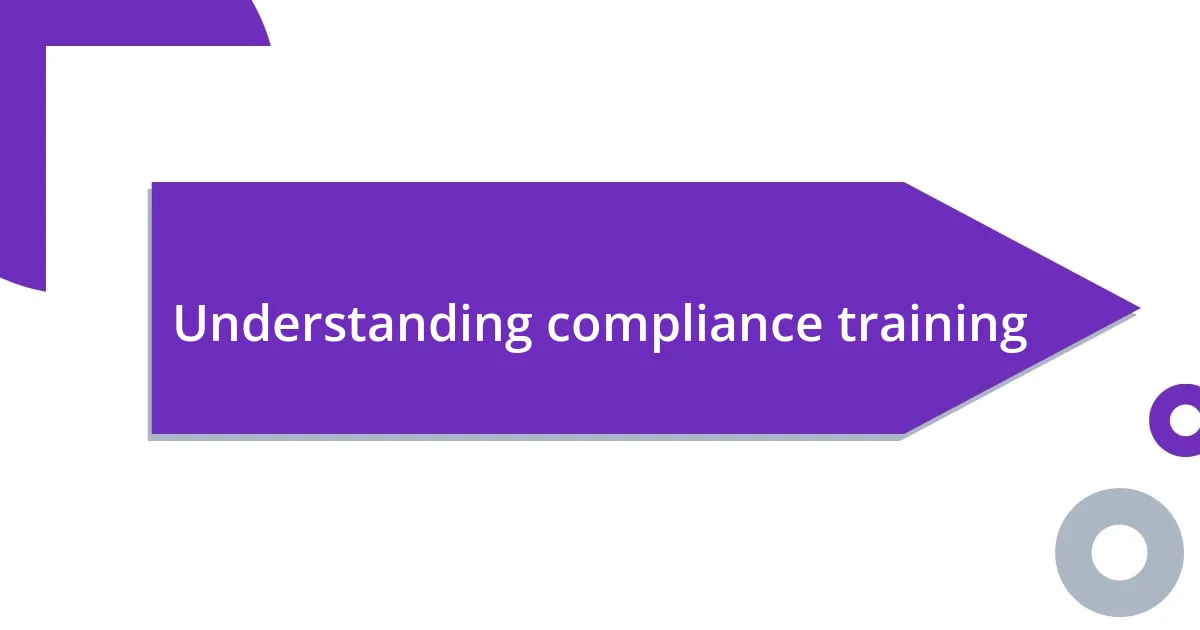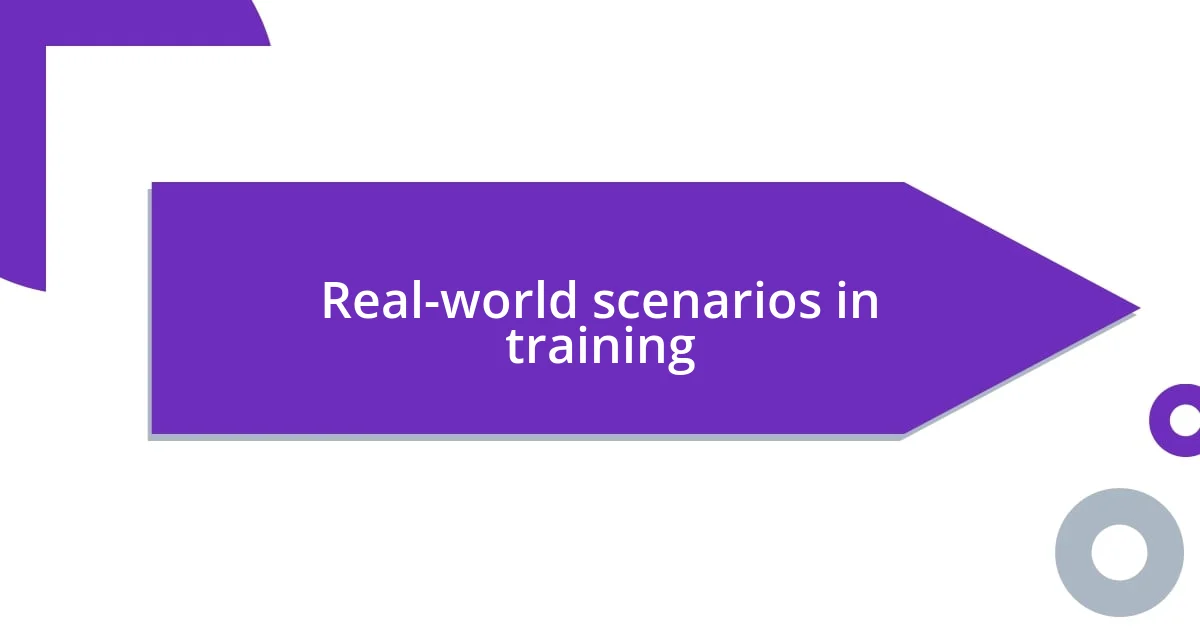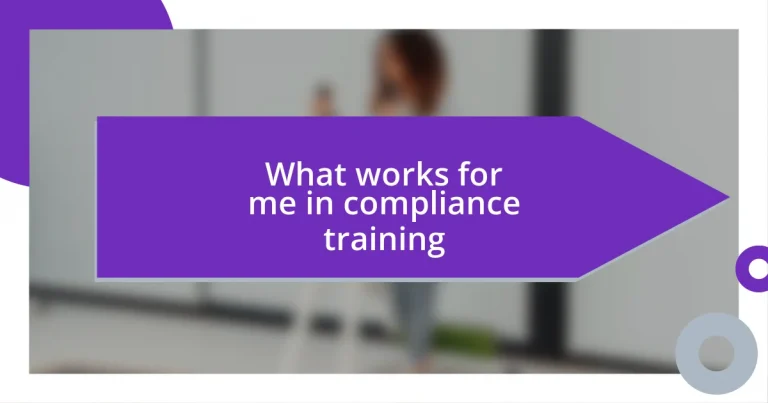Key takeaways:
- Interactive training methodologies, such as scenario-based learning and gamification, significantly enhance employee engagement and retention of compliance concepts.
- Utilizing real-world scenarios and storytelling in training fosters emotional connections, making compliance training more relatable and impactful for employees.
- Continuous improvement through feedback loops, collaborative learning, and integrating compliance discussions into regular business conversations reinforce a culture of accountability and long-term compliance success.

Understanding compliance training
Compliance training is more than just a box to check; it’s fundamentally about fostering a culture of integrity and accountability within an organization. I remember my first experience in compliance training, sitting in a room filled with new colleagues. Initially, it felt tedious, but as we delved into real case studies and discussed the implications of non-compliance, I realized the weight of our responsibilities. Have you ever considered how critical it is for every employee to understand the rules that govern their actions?
At its core, compliance training aims to equip employees with the necessary knowledge to navigate complex regulations and ethical standards. I’ve been in a few sessions where the facilitator used role-playing scenarios to bring the concepts to life—this approach transformed the theoretical into a tangible experience. When I faced a dilemma at work regarding data privacy, the lessons from that training clicked into place, empowering me to make informed decisions.
Ultimately, effective compliance training creates an environment where employees not only grasp rules and laws but also understand their broader impact on the company’s reputation and success. Each training session can spark a discussion about values—something I find so crucial in today’s corporate landscape. Isn’t it fascinating how these training experiences can shape not just individual actions but also collective organizational ethos?

Effective training methodologies
One of the most effective training methodologies I’ve experienced is the incorporation of interactive elements. When participants actively engage, such as through discussions or brainstorming sessions, it fosters a sense of involvement and ownership. I vividly recall a workshop where we break into small groups to tackle compliance scenarios; the energy in the room was palpable, and it sparked insightful conversations that left a lasting impression on all of us. That’s the power of collaboration—it not only enhances understanding but also builds camaraderie among colleagues who are united in their commitment to uphold compliance standards.
Here are some training methodologies that have proven effective for me:
- Scenario-Based Learning: Using realistic scenarios encourages employees to think critically and apply their knowledge in practical situations.
- Gamification: Incorporating game elements, like quizzes or competitions, can make learning more enjoyable and memorable.
- Microlearning Modules: Short, focused training segments cater to busy schedules and improve retention by breaking down complex information.
- E-Learning Platforms: Offering flexibility, these platforms allow employees to learn at their own pace while still providing interactive content.
- Continuous Feedback: Facilitators who provide immediate feedback during training help reinforce key concepts and correct misunderstandings in real time.
These methodologies not only make training sessions more engaging but also ensure that vital information resonates long after the training ends.

Engaging training techniques
Engaging training techniques are essential in making compliance training enjoyable and effective. One technique that stands out is the use of gamification. I remember a training session where we split into teams to answer compliance-related trivia. It turned into a friendly competition that ignited excitement and enthusiasm; I couldn’t believe how much I learned while having so much fun. This approach not only made the content stick but also built teamwork among us, essential for a culture that values compliance.
Another method I’ve enjoyed involves leveraging storytelling during training. Sharing real-life experiences; including both successes and pitfalls, can make the material relatable. I once attended a session where the speaker described a compliance failure and its repercussions. It hit me hard, reminding me that our decisions have real consequences. This emotional connection helped us understand the ‘why’ behind the rules, making the training feel personal and impactful.
Finally, incorporating technology like mobile apps for on-the-go training can significantly enhance engagement. I downloaded a compliance app that sent me daily tips and quizzes. The convenience of learning in brief snippets adapted to my busy schedule made compliance knowledge an integral part of my everyday routine. This kind of flexibility caters to different learning styles and promotes continuous engagement, allowing employees to grow their understanding over time.
| Engaging Technique | Description |
|---|---|
| Gamification | Incorporating game-like elements increases motivation and interaction during training sessions. |
| Storytelling | Sharing real-life experiences helps participants connect emotionally and grasp the importance of compliance. |
| Mobile Learning | Apps and tech offer flexible, bite-sized training that fits into busy schedules, promoting ongoing learning. |

Real-world scenarios in training
Real-world scenarios in training have often brought the concepts of compliance to life for me. I recall an instance where we were presented with a specific situation involving a potential data breach. Small teams had to analyze the scenario and suggest actions. This exercise sparked a lively debate, and as I listened to my colleagues share their perspectives, I realized how these discussions made the compliance norms more tangible. Could we have acted differently? That sharp realization drove home the importance of understanding the ‘why’ behind protocols.
Another memorable training experience involved a mock audit scenario. I played the role of the compliance officer, responsible for answering challenging questions posed by the audit team. With each question, I felt a knot tightening in my stomach, revealing how pressure can influence decision-making. This setup helped me appreciate not only the regulations we need to follow but also the critical thinking required to navigate complex situations. It was an eye-opener—what would I do in a real-life audit?
Sometimes, it’s the unexpected situations encountered during training that leave a lasting impact. During one session, a facilitator introduced an ethical dilemma that required quick decision-making. The room fell silent as we grappled with conflicting choices, really forcing us to weigh the options based on our values and the company’s compliance standards. That moment of introspection made me realize the kind of courage and integrity required in compliance roles. How would I ensure compliance under similar pressure? I found myself reflecting on my personal values and how they align with my professional responsibilities, reinforcing the significance of ethical decision-making in my daily work.

Measuring training effectiveness
Measuring the effectiveness of compliance training goes beyond simple attendance or completion rates. For example, I had my doubts about a particular training program’s impact until we implemented pre- and post-training assessments. This approach not only gauged retention but also highlighted areas needing further emphasis. The difference in scores was a revelation, showing how targeted training can enhance understanding—and my confidence in the program’s effectiveness soared.
One particularly illuminating experience was when my organization created a feedback loop after training sessions. Participants could share their thoughts on real-world applications of what they learned. I remember reading responses from colleagues who implemented new compliance strategies in their work, and it felt rewarding to see the training’s tangible impact. This dialog led to program adjustments that made it even more relevant, which made me reflect: how often do we incorporate feedback to fine-tune our training initiatives?
Lastly, I’ve found that measuring effectiveness through observational methods can be incredibly insightful. During team meetings, observing my colleagues’ discussions around compliance tasks showed me how well they internalized concepts. It struck me as a powerful reminder—real-life application really tells the story of our training’s success. This led me to ask: are we prioritizing real engagement over rote learning? In my experience, it’s the adaptive application of knowledge that ensures compliance truly resonates within an organization.

Continuous improvement in compliance training
Continuous improvement in compliance training isn’t just a directive; it’s an ongoing journey that I truly believe in. In one instance, our team decided to schedule regular check-ins after training sessions. As we gathered weeks later to discuss challenges and successes, I felt a sense of camaraderie in sharing our experiences. Did we really absorb the material? These meetings became a breeding ground for idea exchange, and I saw firsthand how collective feedback sharpened our understanding.
A game-changer for me was when I introduced a buddy system where colleagues paired up to share insights from the training. The conversations we had created a vibrant learning environment, and I was pleasantly surprised by how much I learned from others’ interpretations of the material. It got me thinking—are we truly leveraging each other’s experiences to enhance compliance training? I felt energized witnessing how collaborative learning transformed our discussions from mundane to meaningful, reinforcing concepts I thought I had already grasped.
One of my favorite initiatives involved inviting guest speakers who specialized in compliance matters. Their different perspectives made compliance issues feel less abstract and more relatable. Listening to their stories about navigating roadblocks was both enlightening and motivating. I often reflected on how their experiences echoed my own struggles in understanding complex regulations. This made me ponder: how can we continue to bring in fresh voices to keep our training relevant? For me, it emphasizes that continuous improvement isn’t just about updates; it’s about integrating diverse experiences that resonate with our day-to-day challenges.

Best practices for long-term compliance
Building a culture of accountability is a cornerstone of long-term compliance. I recall a time when we introduced a peer-review process where team members could anonymously evaluate each other’s compliance practices. Seeing my colleagues take ownership of their responsibilities was eye-opening; it wasn’t just about following rules anymore, but fostering a shared commitment to uphold standards. How often do we create environments where everyone feels responsible for compliance?
Another effective approach I’ve witnessed is integrating compliance into regular conversations rather than isolating it to specific training sessions. For instance, I remember during quarterly meetings, our leadership team would highlight compliance wins alongside business achievements. It felt invigorating to discuss our compliance journey as part of our overall success narrative, reinforcing its significance daily. I often wondered: are we adequately celebrating compliance milestones to keep motivation high?
Lastly, I found that leveraging technology can significantly enhance long-term compliance efforts. Implementing a compliance management platform allowed for real-time updates and access to resources, making it easier for everyone to stay informed. I remember the first time a colleague expressed gratitude for being able to access training materials on-demand. It made me reflect—are we truly utilizing the tools at our disposal to embed compliance into the fabric of our workplace? Embracing technology not only simplifies learning but also keeps compliance at the forefront of our daily operations.














